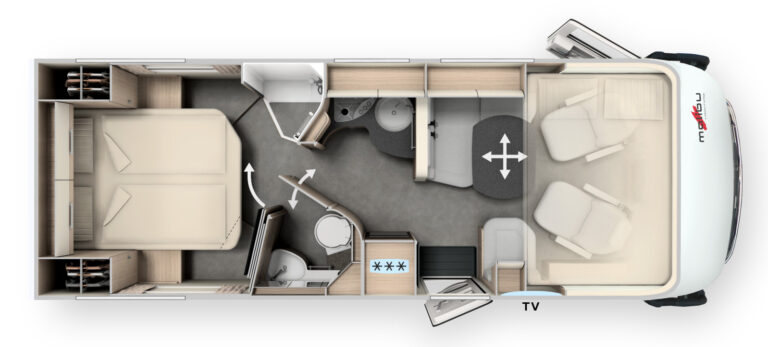Cosy
The Malibu I 500 RB-QB has an L-shaped lounge seating area with pull-out shoe cabinet and wide, swivel-up side bench seat, comfort corner kitchen and comfort luxury bathroom with fully separable dressing room so you can enjoy the best holidays. In addition to this, there is the cosy queen-size bed with large sleeping area.


Your new camper van or motorhome are waiting for you. You just need to find out where! Find our Malibu dealers near you.
| Weight in driveable condition according to sales documents: | 2,900 kg |
| Legal tolerance of ± 5%: | 145 kg |
| Legally permissible range of weight in driveable condition: | 2,755 to 3,045 kg |
| Minimum payload in kg ≥ 10 * (n + L) |
| Whereby the following applies: „,n” = maximum number of passengers plus the driver and,,L” = total length of vehicle in metres (including decimal places). |
| For a motorhome with a length of 7 m and 4 approved seats (including the driver), the minimum payload is 10 kg * (4+7) = 110 kg, for example. |
| 3,500 kg | Technically permissible gross weight |
| – 2,900 kg | Weight in driveable condition |
| – 3*75 kg | Weight of passengers |
| – 110 kg | Minimum payload |
| = 265 kg | Additional equipment |
| 3,500 kg | Technically permissible gross weight |
| – 2,929 kg | Actual weight in driveable condition of the vehicle (+1% on comparison to compared to the 2,900 kg specified in the sales documents) |
| – 3*75 kg | Weight of passengers |
| – 265 kg | Weight of additional equipment |
| = 81 kg | Actual payload (< minimum payload of 110 kg); in this example, the minimum payload is therefore undershot by 29 kg |
| 3,500 kg | Technically permissible gross weight |
| – 2,929 kg | Actual weight in driveable condition of the vehicle (+1% on comparison to compared to the 2,900 kg specified in the sales documents) |
| – 3*75 kg | Weight of passengers |
| – 150 kg | Additional equipment ordered for the specifically configured vehicle |
| = 196 kg | Actual payload |
You need to load content from reCAPTCHA to submit the form. Please note that doing so will share data with third-party providers.
More InformationYou are currently viewing a placeholder content from Facebook. To access the actual content, click the button below. Please note that doing so will share data with third-party providers.
More InformationYou are currently viewing a placeholder content from Instagram. To access the actual content, click the button below. Please note that doing so will share data with third-party providers.
More InformationYou are currently viewing a placeholder content from Google Maps. To access the actual content, click the button below. Please note that doing so will share data with third-party providers.
More InformationYou are currently viewing a placeholder content from Google Maps. To access the actual content, click the button below. Please note that doing so will share data with third-party providers.
More InformationYou are currently viewing a placeholder content from Mapbox. To access the actual content, click the button below. Please note that doing so will share data with third-party providers.
More InformationYou are currently viewing a placeholder content from OpenStreetMap. To access the actual content, click the button below. Please note that doing so will share data with third-party providers.
More Information